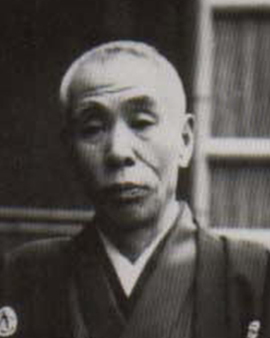Seiho Takeuchi was a Japanese painter and master of the pre-war Kyoto circle of painters, born and raised in the city of Kyoto in Japan. Schooled in the genre of Nihonga painting, Takeuchi was active from the Meiji to the early Shōwa era. His birth name was Takeuchi Tsunekichi.
His first artistic ambitions appeared in his childhood, and his parents supported them. They enabled their son to study art at the Maruyama-Shijō School of Traditional Painting under the direction of the painter Kōno Bairei. Afterwards, the talented Takeuchi attended the Kyoto Academy of Art. His ambition and talent did not go undetected. In 1900, he was granted a government-funded art trip to Europe. Now 36 years old, he set out to experience art activities in several European countries, especially France. While Takeuchi's painting style had previously been light and delicate in the manner of the nihonga genre, this changed drastically. After his two-year stay in Europe, he became famous as a painter with a distinctively Western style. In the eyes of strict traditional Japanese painters, this was a strange turn of events, but it did not lower Takeuchi's popularity. On the contrary, his contemporaries were excited because the West seemed promising and interesting.
Takeuchi's favorite subjects were flora and fauna, often in combination. Usually the focus of his work is a plant and or an animal. His favorite animal, the monkey, he liked to paint in humorous poses. The Japanese artist was able to depict the movements of fish in water particularly vividly. So excellently captured that he was said to be the first artist in traditional Japanese painting to accomplish this. His most famous paintings are Kawaretaru Kawaguchi, Saru-to Usagi, Usei as well as Are-Yudachi-ni.
During his lifetime, Takeuchi exhibited regularly at the Ministry of Education in Kyoto, thus reaching a large audience. In honor of Prince Shotuku, his masterpieces Saba (Mackerel), Neko (A Cat), and Keai (Cockfight) were displayed at the Tankokai Art Society.
In addition to his work as an artist, Takeuchi acted as a juror at various art exhibitions that were government-sponsored. He also accepted teaching positions at both the Kyoto Municipal Art and Craft School and the Kyoto Municipal Art College, each at a mature age. Among his most talented students were Bakusen Tsuchida, Shiho Sakakibara, Suisho Nishiyama, and Kansetsu Hashimoto. Later, Takeuchi established his own art school.
Not only the Imperial Academy of Art in Kyoto appointed Takeuchi as a member in 1919. The Japanese artist also won the hearts of art lovers internationally. In 1930 Takeuchi was awarded the French Legion of Honor. This was followed by the French Medal of Culture in 1937. In addition, the painter, who was very popular in Europe, became an honorary member of the Imperial Art Board, the Salon of France and the Academy of Art.
×





 - (MeisterDrucke-240932).jpg)
 - (MeisterDrucke-240932).jpg)
 - (MeisterDrucke-173592).jpg)
 - (MeisterDrucke-173592).jpg)
.jpg)
.jpg)
 - (MeisterDrucke-185961).jpg)
 - (MeisterDrucke-185961).jpg)
_-_(MeisterDrucke-156141).jpg)
_-_(MeisterDrucke-156141).jpg)
.jpg)
.jpg)
.jpg)
.jpg)
.jpg)
.jpg)
.jpg)
.jpg)
 - (MeisterDrucke-247493).jpg)
 - (MeisterDrucke-247493).jpg)
.jpg)
.jpg)
.jpg)
.jpg)
.jpg)
.jpg)
.jpg)
.jpg)
_-_(MeisterDrucke-1363093).jpg)
_-_(MeisterDrucke-1363093).jpg)
_-_(MeisterDrucke-1363084).jpg)
_-_(MeisterDrucke-1363084).jpg)
.jpg)
.jpg)
 And Rat (colour woodblock print) - (MeisterDrucke-150464).jpg)
 And Rat (colour woodblock print) - (MeisterDrucke-150464).jpg)
_-_(MeisterDrucke-1363647).jpg)
_-_(MeisterDrucke-1363647).jpg)
.jpg)
.jpg)
_-_(MeisterDrucke-1362787).jpg)
_-_(MeisterDrucke-1362787).jpg)
.jpg)
.jpg)






